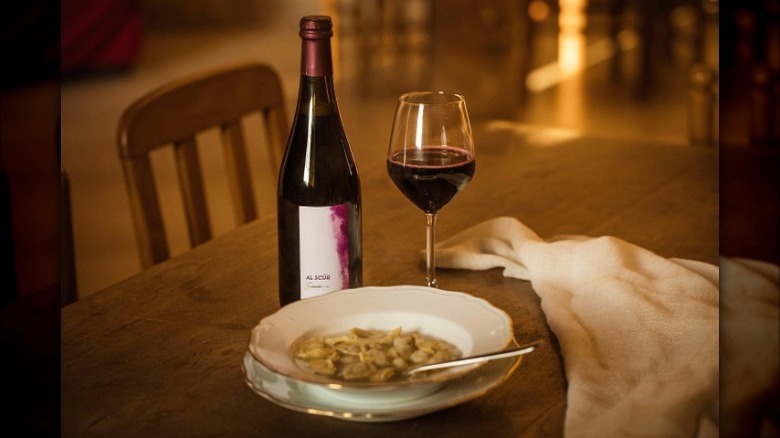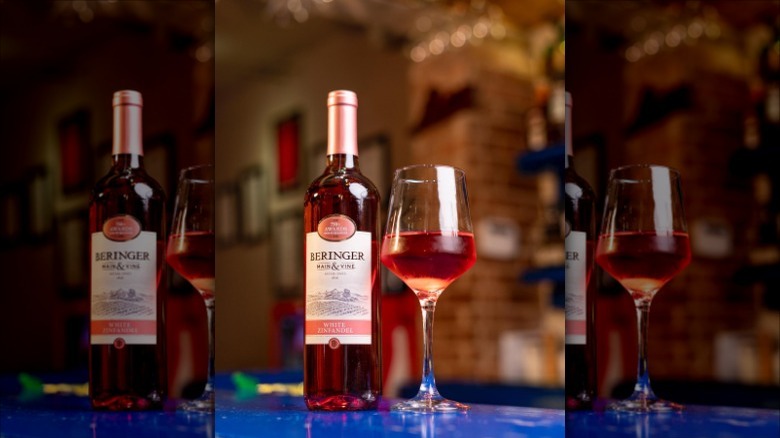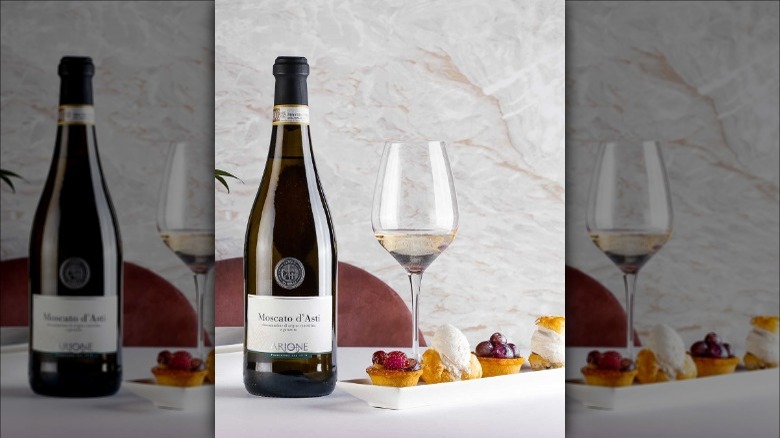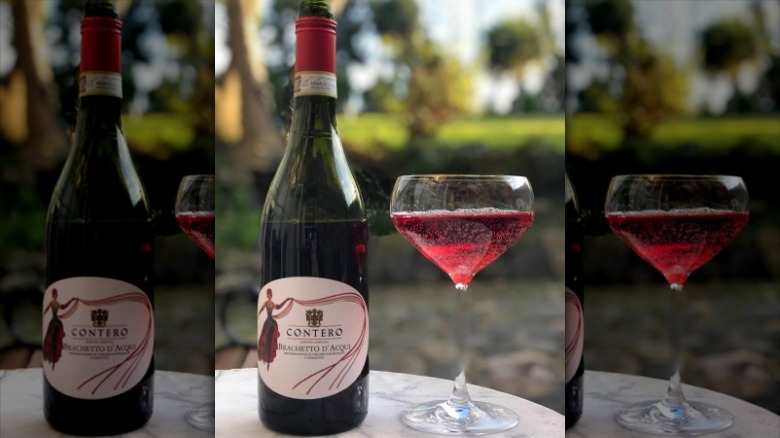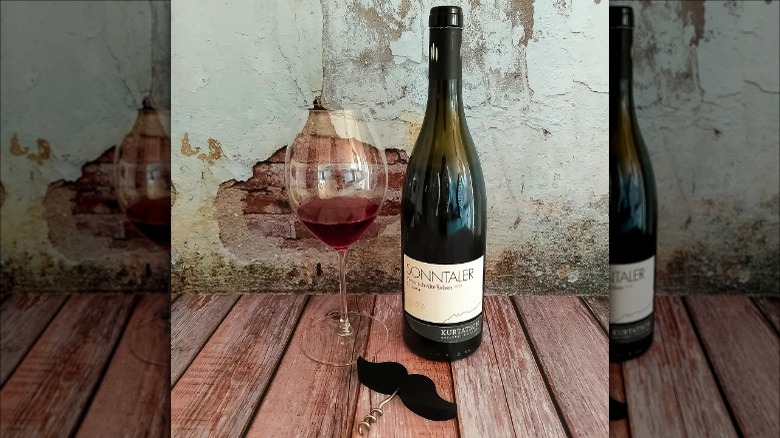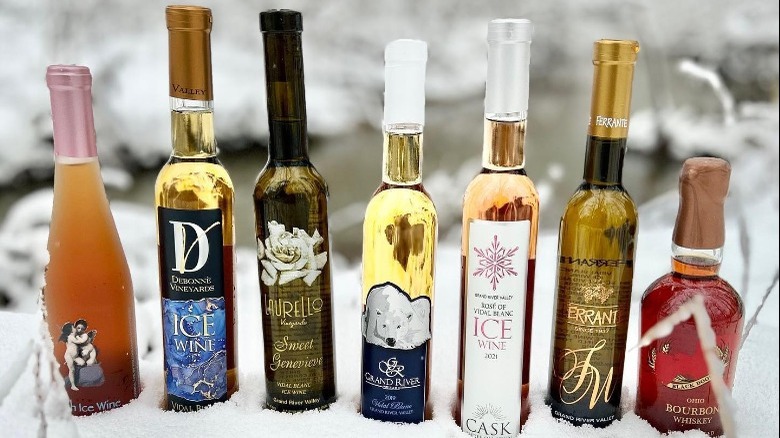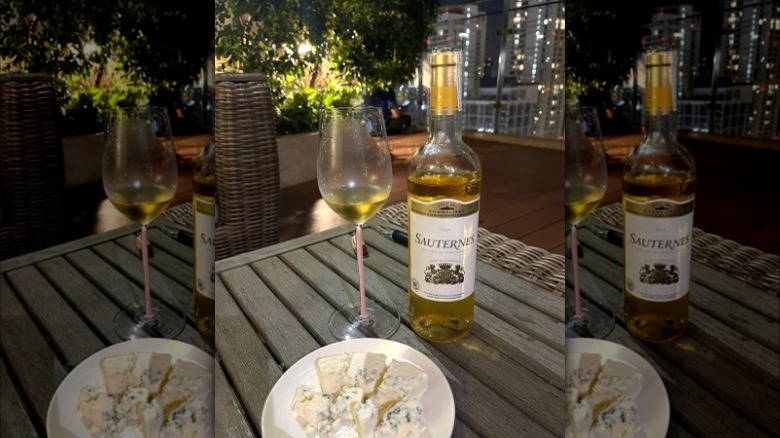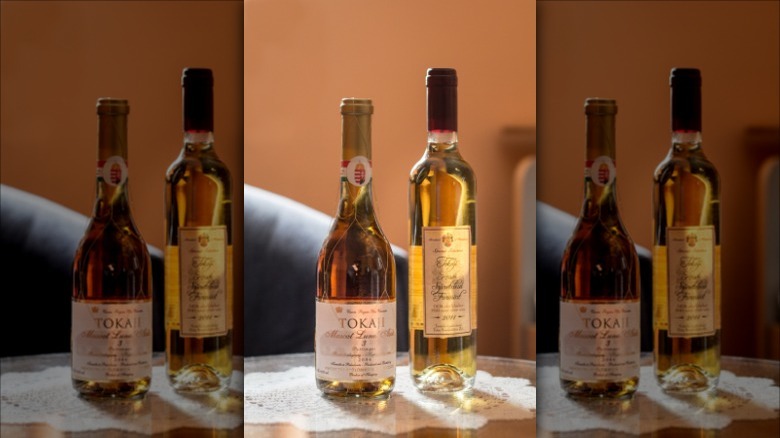13 Sweet Wines Perfect For Beginners
With such a vast variety of wine in the world, it's no wonder that trying a glass, or outright buying any bottle, can feel daunting. It's not that wine is specifically an acquired taste, but the tannins in wine can make some varieties bitter and the acidity levels in wine can produce a sour taste. So how do you know what flavors you prefer, and where do you even start? Sweet wine is an ideal choice for beginners because the sweetness can dull down the bitterness of tannins or the sourness of acidity. It also comes in every type: Red, white, and rosé.
Sweet wines can be perfect for sipping as a dessert, and they have a diverse array of flavors that are bold and fruity. If you've considered what life would be like as a wine aficionado, or are just ready to venture into the realm of wines, choosing a sweet wine is a great place to start. Here, we've compiled a list of sweet wine varieties fit for beginners.
1. Lambrusco
Originating in Italy, this lightly sparkling red wine is made from a blend of Lambrusco grapes that produce a sweetness that evokes other fruits. Contrary to its ingredients, wine does not taste solely like grapes. While expensive brands can be multidimensional, with rich and savory notes, inexpensive brands are often sweet, fruity, and less dry. Some of the fruity flavors that have been present in Lambrusco wine are watermelon, raspberry, cherries, and strawberries. But this variety of wine can also consist of earthy flavors like rose, violet, and herbs.
Taking the origin into consideration, these wines pair very well with Italian cuisine. Cured meats, olives, and cheese, such as Parmigiano Reggiano, can all go alongside a glass of Lambrusco, making it a prime choice for charcuterie. Hearty Italian dishes like pasta and pizza also go well with this wine, which could make for a tasty, inexpensive date meal. In addition to Italian dishes, Lambrusco also can be paired with spicy foods. Its sweetness combats the spiciness of cuisine like Thai or Indian. And if you want to layer on the sweetness, try this wine with a fruity dessert. Best served chilled, this wine is delicious any time of the year but is especially refreshing during spring and summer.
2. White Zinfandel
In the past, zinfandel has often been regarded as cheap with a lower quality taste; however, it is now becoming increasingly popular. With good reason, too, as zinfandel wines are an ultimate choice for those who want to try a sweet wine. Zinfandel comes in both red and white, but despite being called white zinfandel, this variety is actually a pink color. In general, zinfandel wines are relatively cheaper than other wines because they have a high heat tolerance with a large production rate. Don't get us wrong — we love a good bargain. That said, while the cost-effectiveness made Zinfandel wines easy to put out there for a low price, it also meant that the quality wasn't always up to par.
Now, white zinfandel is in the middle of a comeback, with new winemakers changing how it's made and turning it into more of a dry rosé. This cuts back on some of the sweetness it's known for while maintaining the overall flavor. With a flavor profile of slight acidity combined with fruits such as strawberry, cherry, or lemon, white zinfandel is complemented by dishes like smoked meats, grilled chicken, soft cheeses, and boldly flavored vegetables like caramelized onions or zucchini.
3. Port
This sweet wine from Portugal is just one of many from the world's least expensive wine country. Although it is typically considered a dessert wine because of its rich, heady sweetness, port wine comes in a wide variety of distinct flavors and can be paired with meals or by itself. Because of its high alcohol content and stout taste, it is meant to be served in a small wine glass specifically for small sips. Fortified and full-bodied, the dessert wine is usually found in two forms: Ruby port and tawny port. The flavors of each vary, with the former being chocolatey with bold berries, and the latter having notes of butterscotch, caramel, and nuts. Tawny port is known to be the sweeter of the two, and it can be even more layered with age, with flavors like hazelnut and almond.
Although these types are more common, port is produced as a red (such as the ruby port), white, and rosé wine. While rosé port tastes of raspberry, cranberry, strawberry, and caramel, white port has flavors of roasted nuts, citrus peel, apricot, and baked apples. No matter which you go with, this wine pairs best with other sweets like fruits, chocolate or caramel desserts, pecan pie, or rich cheeses like bleu cheese. If you are drinking it with a meal, go for smoked nuts or sweet and smoky meats, like BBQ.
4. Riesling
Coming in both dry and sweet varieties, Riesling wine is versatile enough for beginners, but you should read the labels when searching for a sweet kind. Hailing from Germany, sweeter Rieslings will mention terms like Spätlese, Auslese, Beerenauslese, or Trockenbeerenauslese. They might also be labeled as "sweet" or "feinherb". It may seem intimidating, but even if you snag a dry wine, you can still expect an aromatic and flavorful glass. Despite the dryness it can have, it is rather low in tannins so it doesn't linger on the tongue; instead, the sweetness coats the tongue. Even though it's more acidic than some other sweet wines, Riesling has floral notes that balance the acidity. Fruits like apple, pear, apricot, and peach are often present as well as aromas like honey, ginger, or citrus blossom.
With both sweetness and acidity, it is delicious when served with spicy food. Think jerk chicken, Indian and Asian spices, or a classic pairing like spiced duck leg. The flavors of Riesling can mellow out the spices and create a tasty combo. If going for a dessert pairing, go back to the fruits present in the wine, like apple and peach, and try it with a cobbler or pie.
5. Dornfelder
Native to Germany and one of their most thriving grapes, Dornfelder is admired by winemakers for its growing properties. It's high-yielding, simple to grow, and can be aged with ease. Unlike other sweet wines, it isn't heavy in residual sugar but the strong berry flavors make it sweeter. Fruity and complex, Dornfelder can be full-bodied, though not as much as a port dessert wine, or floral and light. Featuring flavors like cherries, blackberries, currant, and even berry compote with sweeter versions, this wine is undeniably bright and bold.
Approachable and great for everyday consumption, this wine can be enjoyed as a dessert on its own or with hearty meals. More of a wine-and-cheese person? Eat some bleu cheese with it. When drinking it with dinner, go for roasted pork or chicken, game meats, delicate fish, or even pizza such as meat lovers or Hawaiian-style. Because it does come as dry wine, too, it's important to read the labels and find one leaning on the sweeter side. In general, the dryness is balanced with the abundance of berries, so it will always be a little sweet, but not usually sickly sweet.
6. Moscato d'Asti
Refreshing and relatively inexpensive, Moscato d'Asti is sweeter than regular Moscato and a prime wine for beginners. In a survey we conducted, Moscato nearly tied with Chardonnay as a fan-favorite, but the d'Asti variety is considered one of the best sweet wines of 2023 according to Liquor.com. Both sophisticated and exceptionally drinkable, this sweet, white wine is lightly carbonated, acidic, and actually kind of fun to drink. Fizzy and flavorful with a lower alcohol content, it is perfect for light drinkers.
Its refreshing, semi-sparkling texture separates it from plain Moscato, but Moscato d'Asti is just one of several varieties of Moscato-based wine. Literally meaning "of Asti", these wines come from the Asti region in Piedmont, Italy. Some of the other kinds include Asti Spumante, which is sparkling and very sweet, and the rare Moscato d'Asti Vendemmia Tardiva which is harvested later and has higher alcohol and sugar levels. All Moscato d'Asti wines are known for flavors like lemon, mandarin orange, and pear with aromas of fresh grapes and peaches. Ideal for sipping on a summer day or with grilled cuisine and dessert, Moscato d'Asti should definitely be on your list of sweet wines to try.
7. Brachetto d'Acqui
Another sweet Italian wine, Brachetto D'Acqui, is from the region for which it was named: Acqui. Luscious and romantic, Brachetto wine is linked back in history to Cleopatra — the legend of Brachetto says that the queen received an original version of the wine from her lovers, starting with Julius Caesar and Mark Antony, and she liberally drank it for its aphrodisiac properties.
But this wine, despite being in a region that overlaps with Asti, is not a Moscato-based wine such as Moscato d'Asti. While it can be thought of as a red version of Moscato, it embodies flavors of cherries, raspberries, and plums instead of a moscato's fruit cocktail flavors. It's compared to its neighbor for good reason, as it is also deliciously fizzy and low in alcohol. There are four types of this wine: A semi-sparkling red, a sparkling spumante, a rare and smooth Passito, and a sparkling rosé.
Keeping in mind the notes of candied berries, black currant, and citrus with a strawberry-forward flavor, Brachetto D'Acqui goes nicely with chocolate, fresh berries, or desserts like a raspberry tart. This wine sings romance and would be perfect to enjoy on a date, so think of splitting a bottle with dessert or packing it for a picnic.
8. Schiava
Maybe you've heard of cotton candy grapes, but have you heard of a wine tasting like cotton candy? Sciava grapes come from Northern Italy, not from the popular fruit, yet the wine tastes remarkably sweet. If you find a German bottle, this variety will be labeled as Trollinger, Vernatsch, or Kleinvernatsch. Even though it's associated with a cotton candy sweetness, Schiava is known for aromas of rose, lemon, and bubble gum leading to strong flavors of red berries, like strawberry and raspberry, and amaretto. Low in both tannins and alcohol content, this sweet and somewhat dry wine is layered with flavors that aren't as sweet as candy, but still delightfully balanced.
Elegant and light, Schiava wine complements foods like fish, game meat, and ginger. Instead of overpowering the fish or being drowned out by robust game, Schiava holds its own with its bright, light-bodied flavor. We recommend serving it with a dish like grilled cod with lemon butter or Southeast Asian cuisine, which is known for flavors of lemongrass and ginger — both pair nicely with Schiava.
9. Grenache
Born in the Spanish region of Aragón, Grenache (also called Garnacha) is a smooth, medium-bodied wine with multifaceted flavors. Found now in several regions, the Grenache grape is very popular. Vines of this varietal cover a large part of Châteauneuf du Pape, a village within the Rhône wine region of Southeastern France. Sometimes, the grape is used in blends, but whether it's blended or on its own, Grenache is potent.
Spicy and sweet, this is a top choice for beginners who want to try a sweeter wine juxtaposed with a bold, peppery flavor profile. With a sweetness from berries and black cherries, and a bite from white pepper, cinnamon, and tobacco, Grenache is exceptionally unique. When tasted blind, its spicy, fruit roll-up taste instantly separates it from other sweet reds. Having a combination of contrasting flavors makes Grenache versatile, so it pairs with an array of cuisine. Grilled and braised meats, lightly spicy recipes, and herbaceous foods like roasted or seasoned veggies are all perfect for this wine. Because Grenache is so complex, you can really experiment with pairings.
10. Ice Wine
Particularly difficult and extensive to make, ice wine is one of the sweetest you can get. Before they are even turned into wine, the grapes used for ice wine become incredibly sweet naturally. When grapes, usually white varietals, begin to freeze at the end of harvest season as temperatures drop to 20 ºF, winemakers brave the weather to pick the frozen grapes and begin the ice wine process. As grapes freeze, the water inside them hardens and thaws, but the sugars become concentrated as they remain unfrozen. Resulting in a sweet, saturated flavor, the grapes are then fermented until they become a fruity, innately sweet wine.
Typically, this is popular in colder climates, like those in Canada, Germany, and even Michigan. Several different grapes can endure colder climates, like Riesling, Vidal Blanc, Merlot, and Cabernet Franc, which are most commonly found in Canada, and any of these will produce worthy ice wine. In countries where the frozen grapes are procured commercially, or frozen after they're harvested, the wine legally cannot be labeled as ice wine. Instead, it must be labeled as the very close "iced wine" or simply "dessert wine". True ice wine is on the more expensive end because its intricate production requires naturally frozen grapes to achieve an authentic flavor, which is honey-sweet without being cloying, so be sure to look closely at labels to get the real deal. If you want to experience ice wine at its finest, book a trip to Niagara for their annual Ice Wine Festival.
11. Rosé d'Anjou
Out of Loire Valley in France, Rosé d'Anjou is easily approachable for beginners with its moderately sweet flavor and fresh acidity. Overlapping with Cabernet d'Anjou, both appellations are grown specifically in Loire Valley, and both come from the varietals Cabernet Franc and Cabernet Sauvignon. Despite what the Cab suggests, the two wines are pink in color. Either rosé can be expected to be on the sweeter side, off-dry, and tangy with a counterbalance of acidity.
Cabernet d'Anjou and Rosé d'Anjou both exhibit notes of red currant, strawberries, and citrus. While similar, a Rosé d'Anjou boasts subtle hints of pepper, adding another layer of flavor. Depending on the method, rosé wines can be sweet or dry, but d'Anjou is a harmony of both. These wines partner well with smoky, barbequed, or grilled food and are diverse enough for spicy, sweet, or savory dishes. For dessert pairings, have a go at recipes with fresh strawberries and cream.
12. Sauternes
Although a noble rot wine might not sound appetizing (seriously, rotting grapes?), this method of wine-making is surprisingly tasty. Simply put, "noble rot" is a fungus that decays wine grapes and creates an intense complexity of sweetness and flavor. Not what we expected, either, but some varietals benefit from this. Sauternes, from Bordeaux, is one of them. Full-bodied and dessert-like, this white wine comes from three grapes: Sémillon, Sauvignon Blanc, and Muscadelle. Sure to satiate your sweet tooth, the succulent French dessert wine is sweet as honey, with a symphony of flavors like apricot, butterscotch, toasted baking nuts, honeysuckle, and citric fruits.
As with most dessert wines, many will encourage you to drink it alone so it doesn't dominate the sweetness of a dessert dish. Yet this wine can be enjoyed with fruit tarts or cheesecake just as well as it can be paired with bold cheeses and foie gras. Because of its subtly acidic qualities, it marries well with savory poultry dishes, despite being notably sweet.
13. Tokaji
Once a favorite among Hungarian noblemen, Tokaji wine comes from Hungary's region of Tokaj. Now a modern sweet wine, Tokaji was the first documented noble rot wine. Using grapes affected by botrytis cinerea (a form of fungus sometimes called gray mold), 16th-century Hungarian winemakers found a way to use the shriveled grapes to create a super-sweet wine. Since then, other noble rot wines, like Bourdeaux's popular Sauternes around the 1800s, have been developed. The original, however, consists of only six native varietals called Aszú berries which are separated from the other grapes to be used in the making of the wine.
This painstaking method has a delectable outcome of a highly concentrated sweet wine fit for royalty. Distinct flavors and aromas like ginger and saffron are specific to Tokaji wine, in addition to the honey taste associated with noble rot grapes. Rather easy to pair, Tokaji wine is great with charcuterie, blue cheese, foie gras, and spicy cuisine.

